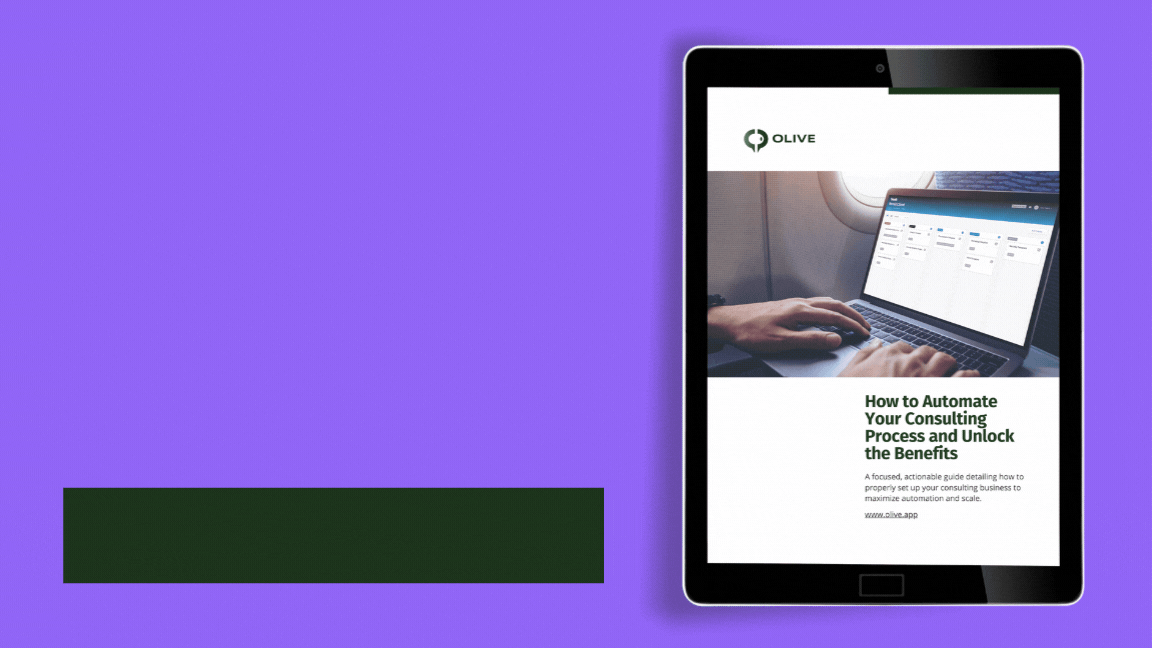Digital Transformation Benefits Consultants in many ways. For starters, Thriving in the new consulting climate is no small feat. The digital revolution, AI, the pandemic and recession have transformed consulting as we know it. With competition more fierce than ever, consulting businesses and consultants alike need to evolve to meet client expectations. To build and sustain a successful Consulting business, you must transform, expand your offering, be a thought leader, use technology and AI to streamline your process and do all of this strategically and efficiently.
Technology is at the forefront of this evolution, and the success of consulting needs to be accordingly redefined to measure up to technological advancements. IT Consultants are helping companies to transform; however, many use archaic and outdated tools and methods. It’s time for consultants to step up and embrace digital transformation before they are pushed aside by vying competitors.
The Future of IT Consulting – What’s Changing?
3 Ways IT Consultants Can Leverage the Benefits of Digital Transformation
1. Generative AI For Consultants
Artificial Intelligence (AI) emerges as a transformative force. As the demand for AI surges globally, consultants and companies are reaping the benefits of integrating AI into their operations. From streamlining invoicing processes to enhancing workflow efficiency, consultants can harness AI to address common challenges in the industry. AI-based consulting billing software, exemplified by platforms like Invoicera, offers a suite of advantages. It not only facilitates the generation of professional invoices based on accurate time tracking but also enables multi-layer security, protecting sensitive client data. The productivity benefits of AI are evident in automating administrative functions, allowing consultants to focus on strategic, value-driven activities. Moreover, AI empowers consultants with robust data collection capabilities, offering precise insights into various business facets.
Beyond efficiency, AI contributes to cost-cutting and profit-boosting, providing customized billing software that reduces operational costs and accelerates payment cycles. Invoicera’s tracking tools further aid consultancies in monitoring invoice positions and seamlessly managing clients and projects. As the AI revolution continues, consultants must embrace these advancements to thrive in the evolving consulting climate, strategically leveraging technology to meet client expectations and stay ahead of competition.
Harness Olive’s AI Capabilities for Seamless RFP Creation
Building on the transformative power of AI, Olive simplifies the RFP creation process with intuitive, AI-driven tools. By automating key steps like drafting, scoring, and collaboration, Olive enables consultants to manage RFPs more efficiently, whether handling a single project or multiple engagements. This reduces manual effort, accelerates decision-making, and delivers consistent, high-quality outcomes—allowing consultants to focus on strategic activities and drive greater value for their clients.
Click here to learn more about Olive’s AI- powered RFP Creation features.
![]()
2. Use Technology to Strengthen your Business Strategy
Today’s business strategy is technology-enabled. Consultants need to leverage technology to inform strategy instead of the reverse. When technology is used correctly, it can help companies achieve their business goals and deliver measurable results. If technology is embraced as an integral part of business strategy, rather than shoved aside as a back-office function – exponential growth can occur.
For consultants, leveraging the benefits of digital transformation requires creating a strategy, getting the input of stakeholders, and deeply understanding business needs. This sets the stage for an effective technology evaluation process that guides you to the right suite of solutions that deliver business value.
Successful transformation requires getting the input of key stakeholders, deeply understanding the unique needs of your customers, and then evaluating the solutions available.
Ironically, lengthy waterfall processes and old-school tools are still used to evaluate a handful of solutions. Transformative and innovative as the process is supposed to be, there hasn’t been much innovation within the system of finding the right solutions. Innovators are using outdated technology to innovate. They are clinging to the ‘old way’ for dear life. Many are married to a nightmarish waterfall process that is too slow for today’s rapid pace of innovation.
A quick google search of “software for consultants” results in a mish-mash of ambiguity and often suggests a suite of 10 solutions, half of which may not integrate. Cross-referencing spreadsheets and multiple productivity tools slows you down, creates more admin work, and increases the risk of human error. Focus on finding the right software that enhances your output and set yourself up to facilitate an agile, collaborative process.
3. Automate your RFP Process
For other professions, we see automation take place at rapid speeds. Let’s take the example of marketers. Marketers have plenty of technological tools at their disposal – such as CRMs and CMSs, to make their jobs easier and automate tedious tasks and processes. However, up until now, consultants have been stitching together multiple tools to run their processes, such as excel spreadsheets, project management tools, and word docs for gathering requirements.
Smaller consulting agencies and independent consultants have a huge opportunity right now, blatantly obvious and staring them right in the face, that many choose to ignore. We can see our world transforming and our business processes becoming more agile. Smaller companies are by nature more agile, and therefore able to adopt new technologies with higher success to automate and streamline their processes. Those consultants taking their niche expertise, and combining it with solutions that streamline their evaluation process, are reaping the benefits. They may even have a leg up on the ‘Big Five’ consulting agencies, which still use spreadsheets and outdated waterfall methods and tend to be less agile due to their size.
4. Use Technology to Facilitate Agile Collaboration
It’s commonplace for leaders to have lightbulb ideas and think that their ideas are ingenious, and often they are. Yet, without identifying or listening to the right stakeholders, these ideas can fail miserably. According to a report from Capgemini Digital Transformation Institute and MIT Sloan School of Management;
“Digital transformations are lagging or even failing for several reasons, including poor leadership, disconnects between IT and the business, lagging employee engagement, and substandard operations.”
Capgemini Digital Transformation Institute and MIT Sloan School of Management
That’s why taking the time to effectively gain consensus is crucial to successful outcomes, especially when it comes to digital transformation and technology evaluations. Many digital transformation efforts fail because a solution is not implemented correctly or adopted by the organization because it does not meet the needs of the business. A major roadblock in finding the right technology is understanding exactly what stakeholders and collaborators need in their ideal solution. Aligning departments and stakeholders will streamline the process for assessing the needs, gathering requirements, discussing and evaluating the right options.
Traditionally this is done by identifying the right stakeholders, interviewing & surveying them, shadowing them to understand their perspectives, pain points, needs and wants. All of this information is manually tracked in word docs, spreadsheets, or project management tools. Those who have done this even once can attest to the countless meetings where the squeaky wheel gets the spotlight while other voices are drowned out. All this before a single vendor has been engaged or had a chance to respond to the requirements. Not to mention all manual collation and comparison that must be done using emails and spreadsheets after receiving vendor responses to requirements.
Using collaboration tools like Olive can make this process more streamlined and far less painful. Capture feedback from around the organization without the overhead of having to meet with everyone individually. Giving everyone a chance to provide input will not only give you a broader perspective on your client’s business needs and wants, but will drive to easier user adoption afterwards The collective buy-in of the team is critical, so make sure that gaining consensus comes top-of-mind when making business decisions, and when it comes to using tech to collaborate and build consensus, Olive will certainly deliver better results faster.
Niche Expertise and the Right Technology Can Help Consultants Leverage the Benefits of Digital Transformation
Building and sustaining a successful consultancy business takes grit, effective strategy, and relentless determination. Olive aims to help consultants digitize their process and release time to build a successful business.
Olive’s process facilitates an agile collaboration process with robust requirement libraries and internal survey features, making it easy to capture, prioritize, and manage business needs and requirements, no matter the complexity. Olive guides you through the technology evaluation process and lets you compare vendor responses to the requirements – getting to a shortlist of solutions often in less than four weeks.
Reap the benefits of decreased admin time, store data in one consultancy tool, manage all clients and projects in the app. You can make templates out of your projects and access requirements and surveys to reuse on future projects and evaluations. With Olive, you can avoid months spent evaluating vendors, only to get to implementation with something going south: users don’t adopt it, the vendors have over-promised and under-delivered, or a crucial stakeholder was missed during the software selection process.
With Olive, you’ll be able to speed up evaluation time. Decreasing time evaluating, gets you to implementation and, ultimately, revenue faster.





